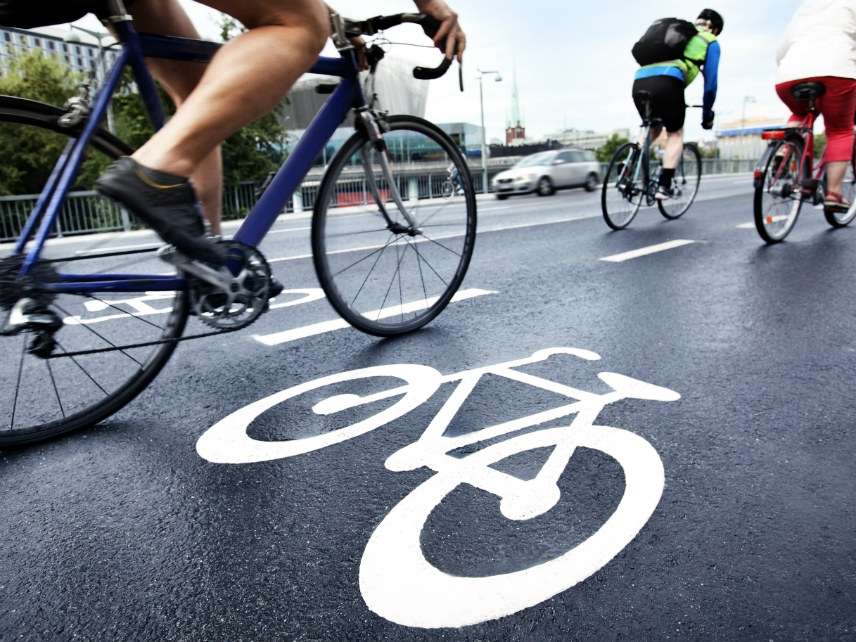Yikes! New Seattle Bike Lanes Were Supposed to Cost $860k per Mile. Some Are Costing $13 Million Instead.
Yet another Seattle transit project goes off the rails.

When the $930 million "Move Seattle" transportation levy appeared on the ballot in 2015, voters were promised some very specific things in exchange for a $275 yearly bump in the city's average property taxes. This included 50 miles of protected bike lanes, 180 miles of repaved arterial roads, and the redesign of seven transit corridors to allow for easier bus, bike, and pedestrian travel.
Then–City Council President Tom Rasmussen also promised "accountability and transparency in how the levy dollars are spent."
Fast-forward three years. Ballooning cost estimates now have city officials saying they will not be able to fulfill every pledge made to voters in 2015—promises that were known to be unrealistic when they were made.
"We do not have enough funding right now to do everything that was promised, we just don't," said the city's interim Department of Transportation (SDOT) chief, Goran Sparrman, at an oversight meeting last week. Sparrman added that "some of those dollar amounts estimated for what projects would cost were clearly insufficient, even at the time."
Take the bike lanes.
The original 2015 levy budgeted about $860,000 for each promised mile of new protected bike lane and greenway. That's a smidge lower than the actual cost of the four-block bike lane project on Seventh Avenue in Seattle's downtown, which came in at $3.8 million (about $13 million per mile). Another bike lane, on Second Avenue, cost $12 million a mile.
A review of the levy's progress gives no precise dollar figure on how insufficient the bike lane budget is, saying only that the program needs "further review and adjustment."
The review says the same for those 180 miles of arterial road repaving that need to be done and those plans to increase bus speed and service on seven congested corridors, not to mention the curb repairs promised at 775 intersections.
Plans to replace any old tree removed by the city with two new trees is still on track, as are stepped-up crosswalk repainting and seismic upgrades to 16 vulnerable bridges.
SDOT blames the cost overruns on a 2016 Americans with Disabilities Act consent decree requiring the city to ugrade more sidewalks than anticipated (despite the city claiming earlier that the consent decree would not affect the delivery of Move Seattle projects), uncertainly about the availability of federal grants (despite the feds boosting transit funding this year and greenlighting several Seattle funding awards), and faster-than-anticipated growth in real estate costs.
That latter explanation has been trotted out for a number of recent transit cost overruns in the Seattle area. Sound Transit, a separate entity from SDOT, said much the same thing when it was revealed that the agency's Lynnwood light rail extension was coming in $500 million overbudget.
Sound Transit also leaned on this excuse when Seattleites learned that a $32 million park-and-ride garage that the agency was building would cost $65 million, or $100,000 a space. Outside estimates put the typical per-space cost of a Seattle parking garage at $25,000–$35,000.
Then there's the Center City Connector streetcar project, managed by SDOT, which started with cost estimates as low as $108 million but has since seen its price tag jump to $200 million, in part because SDOT officials knowingly lowballed some costs by as much as 50 percent. Construction has since been halted while an independent review of the project is performed.
The Seattle government's inability to deliver on the promises it has made to voters and taxpayers has so far failed to produce a political backlash. As Seattle Times columnist Danny Westneat writes, "this pattern of overpromising or outright deception…never seems to get the city in too much hot water with voters. Maybe because we're so desperate for transit and infrastructure improvements."
A big part of the problem is that the department that receives money from a voter-approved transportation levy—SDOT in the Move Seattle case—is the same agency tasked with informing the public what their vote will get them. Levies need only pass once, after all, so the incentive to overpromise is strong.
In the run-up to the Move Seattle vote, SDOT and the mayor's office hosted five community coffee hours (and one happy hour), 35 community meetings, and three mayoral round tables attended by 40 stakeholder groups. SDOT also circulated information via its blog, the Move Seattle website, and online surveys, and it distributed materials at farmers markets, press events, and pop-up tables at community centers.
The stated purpose of this community outreach was to hear what kind of projects community stakeholders wanted. It's not hard to see this all as an effort to butter the public's bread, particularly given that it resulted in an extra $30 million in projects added without any rise in the per-person costs of the levy itself.
SDOT now has the uninviting task of paring down projects or scrapping up more revenue to give voters something close to what they've been promised.
This process is happening at the same time that development is getting underway for another Seattle-area transit expansion, the $54 billion Sound Transit 3 project, which includes a promise to build 62 miles of new light rail.
Expect to keep hearing about an unanticipated spike in real estate prices.
Rent Free is a weekly newsletter from Christian Britschgi on urbanism and the fight for less regulation, more housing, more property rights, and more freedom in America's cities.


Show Comments (66)